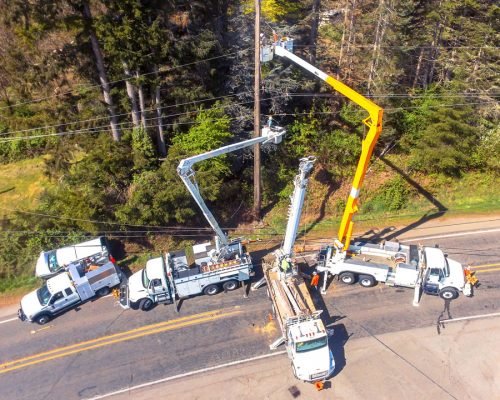 There are usually 13 to 16 linemen available at all times for emergencies, according to Peninsula Light Co., but for the Jan. 6 storm, “all hands were on deck.” Photo: Jim Bellamy
There are usually 13 to 16 linemen available at all times for emergencies, according to Peninsula Light Co., but for the Jan. 6 storm, “all hands were on deck.” Photo: Jim Bellamy
High winds and trees falling across transmission lines led to several power failures between mid-December and mid-January on the Key Peninsula.
Peninsula Light Co. offered an explanation of how power is transmitted to the KP and how the utility co-op responds to a loss of power.
“Transmission lines from Tacoma Power supply power to Peninsula Light. There are multiple transmission lines, with each one supplying about half of the Key Peninsula,” said Ashley Haynes, public relations manager at PenLight.
“Tacoma Power is responsible for maintaining and repairing those lines. Tacoma Power’s transmission lines supply power via taps, or connection points that are a part of the Peninsula Light system, and we are responsible for all the maintenance and repair from that point on,” she said.
The taps are connected to substations where distribution lines then route power to different parts of the peninsula by an intricate grid of supply lines, poles and wires. This grid carries power to the utility poles or underground transformers outside houses or other buildings.
When there is a power outage, PenLight is notified by phone calls or texts from customers or through technical feedback from its automated meter reading system, which sends information to the central office and allows staff to pinpoint the location of the power outage.
Customers with cell phones can sign up for the outage text response program, Haynes said, which enables them to send a simple text whenever the power goes out. When the office is closed, direct customer input by call or text is the quickest way to inform PenLight when there is an outage.
During office hours there is a supervisor available to respond to calls or meter feedback. If a failure occurs after hours, the calls are routed to a call response center and the on-call supervisor is notified. The supervisor then responds, according to established protocols, to find and resolve the problem.
“There are 13 to 16 linemen available at all times,” Haynes said. “But, for instance, in the case of the January 6 storm, all hands were on deck. All of our crews came in to work even before they were called by the supervisor—they knew based on the severity of the storm that there was going to be a lot of damage to repair. Our crews worked nonstop until the power was fully restored.”
The size of the crew will vary from job to job. “If a single street is involved, the crew might be one or two people. If a pole is down at least four will be needed,” she said.
Haynes said that the company has linemen as well as a meter shop and a mechanics shop. The meter and maintenance shop staff are cross-trained so they can work as support staff when an emergency arises. In addition, for big emergencies, there is cooperation with other utility companies and co-ops.
The Jan. 6 outage was caused by a tree falling across a transmission line, leaving nearly 12,000 co-op members without power. The tree was on private land and out of the right-of-way maintained by Tacoma Power. Haynes said that the storm lasted for 90 minutes with gusts of 51 mph before the power failure. Although the crews could begin to work on problems affecting PenLight distribution lines, they could not be sure of the extent of the damage and success of their repairs until Tacoma Power fixed the transmission lines.
Three poles owned by PenLight were replaced. Initial reports about power failure came in at about 2 a.m. Many had power restored by later that morning or early afternoon, but Herron Island was without electricity until about 10:00 p.m. that night.
“Peninsula Light crews and employees are dedicated to the restoration of power and to the safety of our members,” said Jafar Taghavi, CEO of PenLight. “During storms, our members can rest assured that every lineman and crew member are out working to restore power as safely and as quickly as possible.”
Members can stay informed about the progress in restoring power through the PenLight website, where there is a power outage map, or through their Facebook page.
To report an outage, members can call 877-853-1388 from the phone number registered with their account or use the outage text response program. To sign up for the text response program, call PenLight customer service at 253-857-5950.
UNDERWRITTEN BY THE FUND FOR NONPROFIT NEWS (NEWSMATCH) AT THE MIAMI FOUNDATION, THE ANGEL GUILD, ADVERTISERS, DONORS AND PEOPLE WHO SUPPORT INDEPENDENT, NONPROFIT LOCAL NEWS